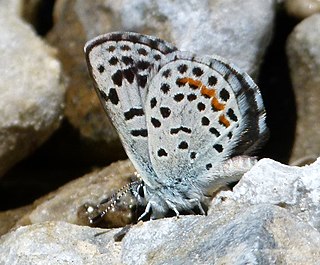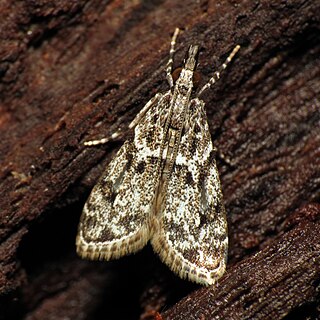
Euphilotes is a genus of butterflies in the family Lycaenidae, which consists of a number of species found in western North America. Some of the species are endangered, such as the Smith's blue, Euphilotes enoptes smithi.
Dichozoma is a monotypic moth genus of the family Crambidae erected by Eugene G. Munroe in 1961. Its only species, Dichozoma parvipicta, was first described by William Barnes and James Halliday McDunnough in 1918. It is found in North America, where it has been recorded from Arizona, California, Utah and Texas.

Hyperstrotia is a genus of moths of the family Erebidae. The genus was erected by George Hampson in 1910.

Idia diminuendis, the orange-spotted idia, is a litter moth of the family Erebidae. The species was first described by William Barnes and James Halliday McDunnough in 1918. It is found in North America from Wisconsin to Nova Scotia, south to Florida and Texas.
Idia julia, or Julia's idia, is a litter moth of the family Erebidae. The species was first described by William Barnes and James Halliday McDunnough in 1918. It is found from southern Canada south to Georgia and Texas.
Renia nemoralis, the tardy renia or chocolate renia moth, is a litter moth of the family Erebidae. It is found in the US from Illinois to south-eastern Massachusetts south to Florida and Texas. The species was first described by William Barnes and James Halliday McDunnough in 1918.

James Halliday McDunnough was a Canadian linguist, musician, and entomologist best known for his work with North American Lepidoptera, but who also made important contributions about North American Ephemeroptera.

Cahela is a monotypic snout moth genus described by Carl Heinrich in 1939. Its only species, Cahela ponderosella, the cahela moth, described by William Barnes and James Halliday McDunnough in 1918, is found in Mexico and in the US states of California, Texas, Arizona, Utah and probably Nevada.

Euphilotes ancilla, the Rocky Mountain dotted blue, is a species of butterfly of the family Lycaenidae. It is found from Washington south to California and southern Alberta and Saskatchewan south through the Rockies and high plains to Wyoming, Colorado, Utah, and northwestern New Mexico. The species was first described by William Barnes and James Halliday McDunnough in 1918.
Nasusina mendicata is a moth in the family Geometridae first described by William Barnes and James Halliday McDunnough in 1918. It is found in the US in southern and central California, extending up the coast as far as Sonoma and Napa counties.
Pediasia ericella is a moth in the family Crambidae. It was described by William Barnes and James Halliday McDunnough in 1918. It is found in North America, where it has been recorded from California and Alberta. The habitat consists of prairies and aspen parklands.
Loxostege anartalis is a moth in the family Crambidae. It was described by Augustus Radcliffe Grote in 1878. It is found in North America, where it has been recorded from coast to coast in Canada. In the west, the range extends south to California.

Eudonia heterosalis is a moth in the family Crambidae. It was described by James Halliday McDunnough in 1961. It is found in North America, where it has been recorded from Nova Scotia to Ontario and southern Quebec, south to Louisiana and Florida.
Noctueliopsis virula is a moth in the family Crambidae. It was described by William Barnes and James Halliday McDunnough in 1918. It is found in North America, where it has been recorded from Arizona, California and Nevada.

Hyperstrotia secta, the black-patched graylet moth, is a moth of the family Erebidae. The species was first described by Augustus Radcliffe Grote in 1879. It is found in North America, where it has been recorded from Alabama, Arkansas, Florida, Georgia, Illinois, Indiana, Kentucky, Louisiana, Maryland, Massachusetts, Mississippi, New Hampshire, New Jersey, New York, North Carolina, Ohio, Oklahoma, South Carolina, Tennessee, Virginia and West Virginia.
Loxostegopsis merrickalis, or Merrick's pyralid moth, is a moth in the family Crambidae. It was described by William Barnes and James Halliday McDunnough in 1918. It is found in North America, where it has been recorded from Alabama, California, Florida, Georgia, Illinois, Indiana, Kansas, Maine, Manitoba, Maryland, Massachusetts, Minnesota, New Hampshire, North Carolina, North Dakota, Ohio, Ontario, Pennsylvania, Quebec, South Carolina, Texas, West Virginia and Wisconsin.

Callistege triangula is a moth of the family Erebidae first described by William Barnes and James Halliday McDunnough in 1918. It is found in North America, where it has been recorded from Arizona, New Mexico and Texas.

Doryodes tenuistriga is a moth of the family Erebidae first described by William Barnes and James Halliday McDunnough in 1918. It is found in North America, where it has been recorded from costal Texas and Louisiana.
Udea berberalis is a moth in the family Crambidae. It was described by William Barnes and James Halliday McDunnough in 1918. It is found in North America, where it has been recorded from California.

Hyperstrotia nana, the white-lined graylet, is a species of moth in the family Erebidae. It is found in North America.











